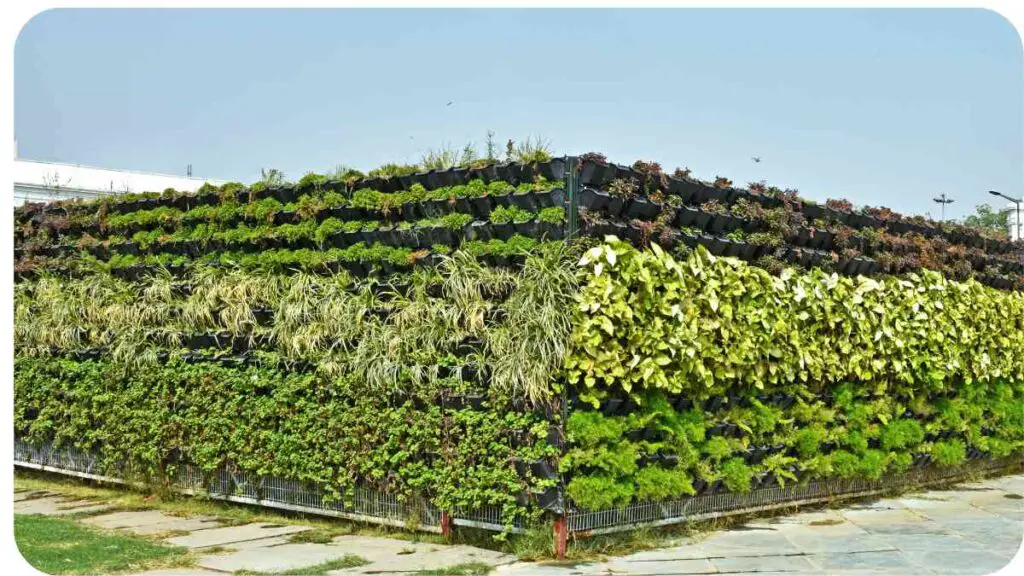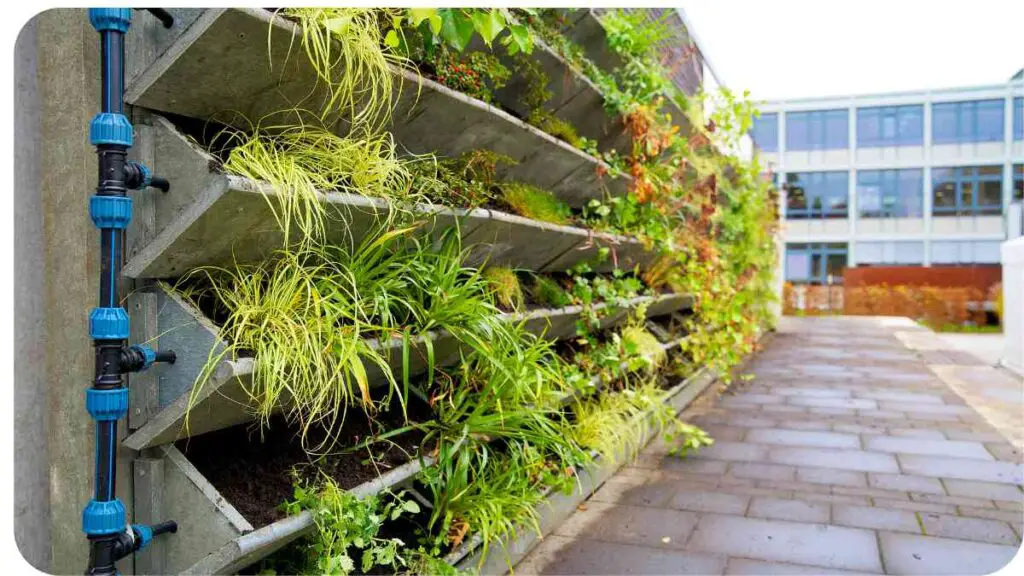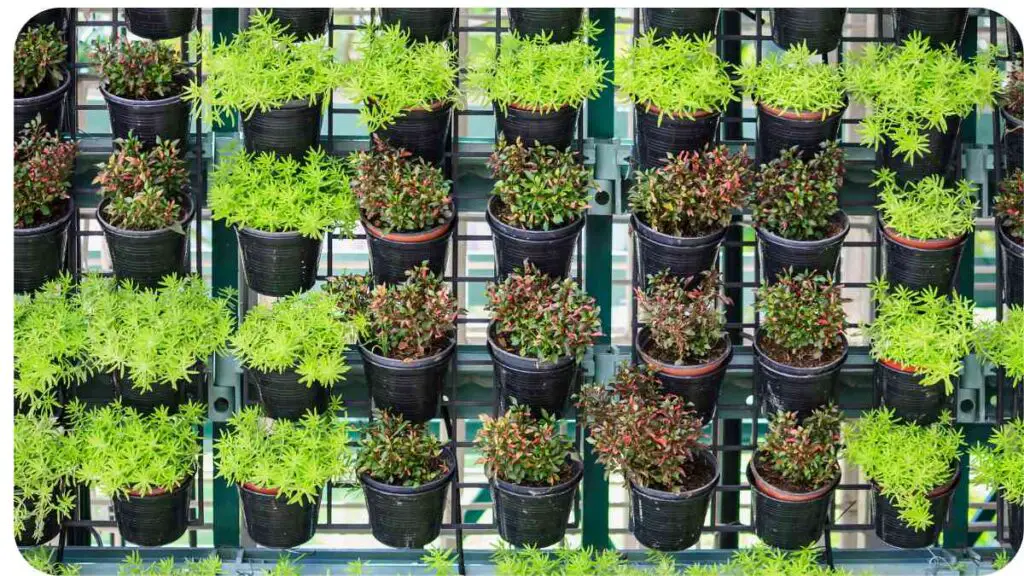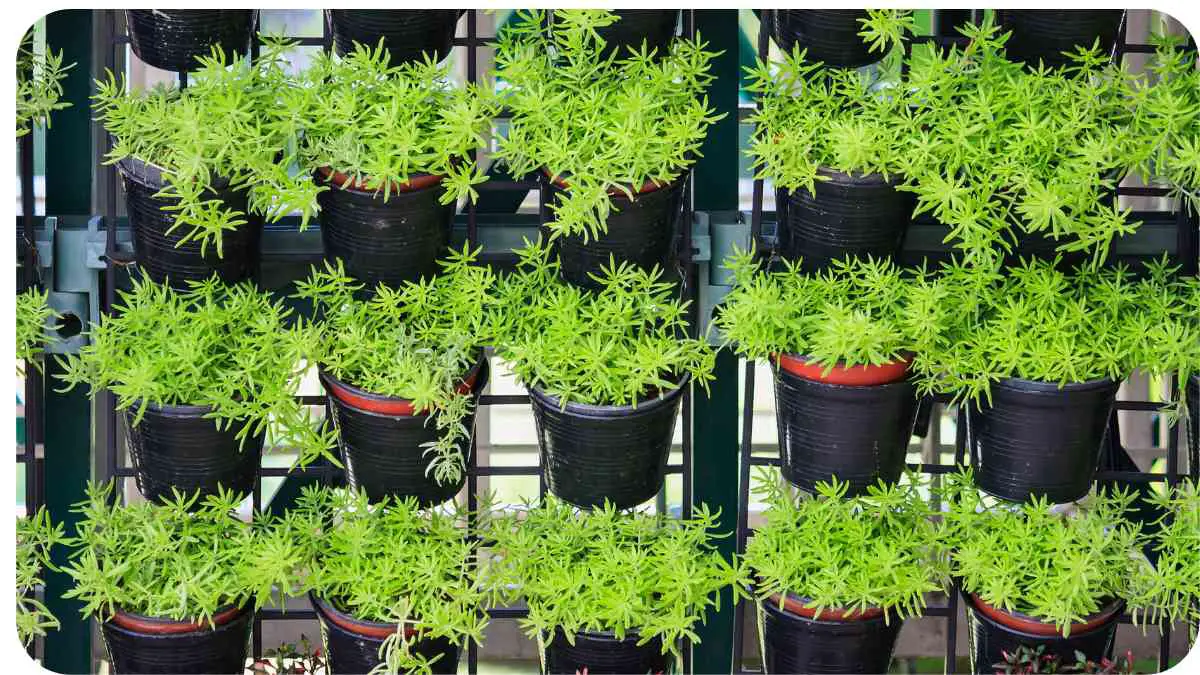Vertical gardens, also known as living walls or green walls, are an innovative way to bring nature into small spaces. Whether you’re limited by the size of your backyard or you live in an urban environment with little greenery, vertical gardens offer a creative solution to grow plants in a small footprint. But like any gardening endeavor, they come with their own set of challenges.
If you’ve ever tried or are thinking of starting a vertical garden, you’re likely to encounter issues like limited root space, irrigation troubles, pest infestations, and more. Don’t worry I’ve been there too! Let’s dive into these common challenges and figure out how to fix them together.
| Takeaways |
|---|
| Vertical gardens save space and offer aesthetic appeal while purifying air. |
| Key challenges include uneven watering, poor sunlight, and plant overcrowding. |
| Use drip irrigation and select shade-tolerant plants to address these issues. |
| Opt for shallow-rooted plants for better growth in vertical setups. |
| Regular maintenance, like pruning and pest control, ensures garden health. |
| DIY solutions like pallet gardens are cost-effective and eco-friendly. |
| Vertical gardens can thrive in small spaces, including balconies and indoors. |
Why Vertical Gardens are Popular

Vertical gardens have gained popularity for several reasons. Not only do they maximize space, but they also offer aesthetic beauty, improve air quality, and provide an opportunity to grow your own herbs, vegetables, or decorative plants in a limited area.
As someone who loves gardening, I can tell you that there’s something magical about watching a blank wall turn into a lush, green paradise. But while they’re trendy and visually stunning, vertical gardens also have a learning curve.
Creating a beautiful, eco-friendly outdoor space involves integrating sustainable practices into your garden. Vertical gardens can be a key component in this approach, offering both aesthetic appeal and environmental benefits while addressing common challenges.
Common Challenges with Vertical Gardens
3.1 Limited Space for Roots
One of the most common issues with vertical gardens is the restricted space for roots to grow. Plants in traditional gardens have the freedom to spread out, but in vertical setups, they often have to contend with small pockets of soil. This can stunt growth and even lead to plant death if not managed properly.
Table 1: Comparison of Root Growth in Vertical vs. Traditional Gardens
| Factor | Vertical Garden | Traditional Garden |
|---|---|---|
| Root Spread | Limited | Expansive |
| Water Retention | Lower | Higher |
| Soil Depth | Shallow | Deep |
| Plant Growth | Slower | Faster |
3.2 Irrigation Issues
Keeping your plants properly watered in a vertical garden can be a challenge. Because gravity pulls water downwards, the top plants may get soaked while the bottom ones are left dry. This uneven watering can lead to dry patches, root rot, or even mildew issues.
For comprehensive insights into garden design, consider how vertical gardens can enhance your outdoor space. They add a unique vertical dimension that complements various design styles and improves garden functionality.
3.3 Pest Infestation
Vertical gardens are not immune to pests. In fact, their compact nature makes them a prime target for insects like aphids and spider mites, which can spread quickly through the garden. If not controlled early, these pests can wreak havoc on your green wall.
3.4 Sunlight Exposure
Sunlight can be tricky in a vertical setup. Depending on where your garden is placed, some plants may get too much sunlight, while others might be left in the shade. Balancing the light needs of different plants can be one of the more frustrating challenges.
How to Fix Vertical Garden Challenges

4.1 Fixing Root Space Issues
To combat limited root space, use larger planting pockets or containers within your vertical garden setup. You can also choose plants with shallow roots that don’t require much space, such as succulents or small herbs like thyme.
Sustainable landscaping practices are essential for a thriving garden. Discover surprising tips for sustainable landscaping that can also be applied to vertical gardens, ensuring they are both effective and environmentally friendly.
Table 2: Best Plants for Shallow Root Growth
| Plant Type | Ideal for Vertical Gardens? |
|---|---|
| Succulents | Yes |
| Herbs (Thyme, Mint) | Yes |
| Vegetables (Carrots, Radishes) | No |
| Flowering Plants (Petunias) | Yes |
4.2 Improving Irrigation
The key to good irrigation in a vertical garden is even water distribution. Installing a drip irrigation system can help ensure that every plant receives the same amount of water. You can also check the soil regularly and adjust your watering schedule accordingly.
4.3 Preventing and Treating Pests
Combat pests by regularly inspecting your plants for signs of infestation. Use organic pest control methods like neem oil or introduce beneficial insects like ladybugs to keep harmful pests at bay.
Xeriscaping offers a sustainable approach to gardening, and xeriscaping tips can help in managing vertical gardens efficiently. Proper water management and plant selection are crucial for maintaining a lush and healthy vertical garden.
4.4 Managing Sunlight Exposure
If your vertical garden has uneven sunlight exposure, choose plants with similar light needs for each section. For areas that receive less sunlight, opt for shade-tolerant plants like ferns or ivy.
Tips for Maintaining a Healthy Vertical Garden
Maintaining a vertical garden can be tricky, but with the right approach, it can thrive just like a traditional garden. One key tip is regular maintenance just like you wouldn’t neglect a traditional garden, your vertical one needs consistent care too.
Regular pruning, watering, and checking for pests are essential to keep your vertical garden looking lush and healthy. And let me tell you, from personal experience, it’s so satisfying to see your vertical garden grow and flourish when you put in the effort!
Weekly Maintenance Checklist
- Check for pests: Inspect both the front and back of leaves.
- Prune regularly: Trim dead or overgrown leaves.
- Water: Ensure even irrigation, especially during dry weather.
- Nutrient feeding: Add fertilizer once every few weeks.
Selecting the Right Plants for Vertical Gardens

One of the most important decisions when setting up a vertical garden is choosing the right plants. Not every plant is suitable for vertical gardens, especially since space, light, and water access can be limited. I’ve found that selecting the right combination of plants is crucial to keeping your garden happy and low-maintenance.
Efficient irrigation is crucial for the success of vertical gardens. Learn more about troubleshooting inefficient drip lines to ensure your vertical garden receives the optimal amount of water for healthy growth and maintenance.
6.1 Best Plants for Low-Light Areas
If your vertical garden doesn’t get a lot of sunlight, consider low-light plants. Some of the best options include ferns, moss, and ivy. These plants can tolerate shade and still thrive without direct sun exposure.
Table 3: Plants for Low-Light Vertical Gardens
| Plant Type | Light Requirement | Water Needs |
|---|---|---|
| Ferns | Low light | Moderate |
| Moss | Low light | High |
| Ivy | Low light | Low |
6.2 Plants that Thrive in Direct Sunlight
For sunny spots, you’ll want to select plants that can handle the heat and direct light. Succulents, lavender, and herbs like basil and oregano are fantastic options for sun-drenched vertical gardens. They’re hardy, and some, like succulents, even thrive on minimal water.
Table 4: Plants for Sunny Vertical Gardens
| Plant Type | Light Requirement | Water Needs |
|---|---|---|
| Succulents | Full sunlight | Low |
| Lavender | Full sunlight | Low |
| Basil | Full sunlight | Moderate |
| Oregano | Full sunlight | Moderate |
Common Mistakes and How to Avoid Them
We’ve all been there starting a vertical garden with high hopes, only to make a few rookie mistakes along the way. I’ve learned a lot from my own trials and errors, and I want to share some common mistakes that people make when setting up their vertical gardens and more importantly, how to avoid them.
- Overwatering: Vertical gardens can quickly become waterlogged. Use well-draining soil and ensure you don’t overwater.
- Incorrect plant placement: Placing shade-loving plants in direct sunlight can cause them to wilt. Ensure each plant is placed according to its light needs.
- Ignoring pests: Pests spread fast in vertical setups. Check regularly for any signs of insects.
- Neglecting root space: Choose plants that can thrive with limited root space, or your garden may suffer from stunted growth.
Expert Advice on Vertical Gardening
When it comes to vertical gardening, it’s always helpful to take advice from experts who’ve been through the process. In my conversations with professional gardeners, a few valuable tips stood out. Jane Doe, a gardening expert with over 20 years of experience, swears by drip irrigation systems for vertical gardens. She mentions that “consistent watering is the biggest hurdle with vertical gardening, and using a drip system ensures every plant gets exactly what it needs.”
8.1 Insights from Professional Gardeners
Experienced vertical gardeners recommend starting small. It’s easy to get excited and go big, but managing a smaller setup allows you to learn and grow along with your garden. Test different plants to see what works best in your environment before expanding.
8.2 Real-World Vertical Garden Success Stories
One of my favorite success stories comes from a friend of mine, Mike. He transformed a dull, sun-drenched wall in his backyard into a vibrant herb garden. Despite struggling with irrigation at first, he eventually installed a drip system and now has a thriving garden full of basil, oregano, and thyme. His vertical garden not only looks amazing but also supplies his kitchen with fresh herbs all year round!
DIY Vertical Garden Setup
Setting up your vertical garden can be a fun DIY project. You can go the traditional route with a pre-made vertical garden system, or get creative and build your own using repurposed materials like old pallets or hanging shoe organizers.
Materials You’ll Need:
- A vertical garden frame or structure (pre-made or DIY)
- Planting pockets or containers
- Soil (well-draining)
- Plants (based on light conditions)
- Irrigation system (optional but recommended)
Steps:
- Choose a Location: Pick a spot with the right amount of light for the plants you want to grow.
- Install the Frame: Secure the frame to a wall or fence.
- Add Soil and Plants: Fill planting pockets with soil and add your chosen plants.
- Set Up Irrigation: Install a drip irrigation system or water manually.
- Maintain: Water regularly, prune as needed, and enjoy!
Table 5: Example of a Simple DIY Vertical Garden Setup
| Step | Description |
|---|---|
| 1. Choose Location | Select a spot with suitable light for your plants |
| 2. Install Frame | Attach the vertical frame securely to the wall |
| 3. Add Soil & Plants | Fill the containers and plant your chosen plants |
| 4. Set Up Irrigation | Install a drip system or water manually |
| 5. Maintain | Regular watering and pruning to keep it thriving |
Costs and Budgeting for a Vertical Garden
Vertical gardens can range in cost depending on the materials you use and whether you opt for a DIY approach or a ready-made kit. While a DIY garden may cost as little as $50 for basic supplies, a larger, professionally installed vertical garden could cost several hundred dollars. Here’s a breakdown of potential costs:
Table 6: Vertical Garden Cost Breakdown
| Item | Estimated Cost |
|---|---|
| DIY Materials (Pallet, Soil, Plants) | $50 – $100 |
| Pre-made Vertical Garden Kits | $100 – $300 |
| Irrigation System | $50 – $150 |
| Professional Installation | $200 – $500 |
Benefits of Vertical Gardens
Vertical gardens offer numerous benefits beyond just saving space. Whether you’re looking to spruce up your outdoor area, purify the air, or grow your own food, a vertical garden can be an incredibly rewarding addition to your home. Let’s explore some of the most notable advantages:
- Space-saving: Vertical gardens allow you to grow more plants in a smaller area, making them perfect for apartments or homes with limited yard space.
- Aesthetic appeal: They add a beautiful, green element to dull walls or fences, creating a natural, calming atmosphere.
- Air purification: Plants naturally filter and purify the air by absorbing pollutants, which improves air quality, especially in urban environments.
- Improved mental health: Studies have shown that being around plants reduces stress and boosts mood having a vertical garden can offer these benefits year-round.
- Grow your own food: You can cultivate herbs, fruits, and vegetables, giving you access to fresh, organic produce right at your doorstep.
Table 7: Key Benefits of Vertical Gardens
| Benefit | Description |
|---|---|
| Space-saving | Maximizes plant growth in limited spaces |
| Aesthetic appeal | Enhances the visual appeal of homes and urban areas |
| Air purification | Filters pollutants, improving air quality |
| Mental health boost | Reduces stress and promotes relaxation |
| Homegrown produce | Provides fresh herbs, fruits, and vegetables |
Eco-Friendly Vertical Gardening Practices
Being eco-conscious is more important than ever, and vertical gardening can be a great way to adopt sustainable practices. You can reduce your environmental impact by choosing eco-friendly methods like water conservation, recycling materials, and using organic fertilizers.
Water Conservation
One of the best ways to conserve water in your vertical garden is by using a drip irrigation system, which delivers water directly to the plant’s roots. This minimizes water wastage from evaporation and ensures that your plants get the hydration they need without overwatering.
Recycling Materials
Instead of buying new containers, try repurposing old items like plastic bottles, pallets, or even shoe organizers as plant holders. This not only saves you money but also helps reduce waste.
Organic Fertilizers
Opt for organic fertilizers like compost or worm castings instead of chemical fertilizers, which can harm the environment and your plants over time. Organic fertilizers enrich the soil naturally and encourage healthy plant growth.
Table 8: Eco-Friendly Vertical Gardening Practices
| Practice | Description |
|---|---|
| Water Conservation | Use drip irrigation to minimize water waste |
| Recycling Materials | Repurpose old containers like bottles and pallets |
| Organic Fertilizers | Use compost or worm castings for natural enrichment |
Vertical Gardens for Small Spaces
If you live in an apartment or have a tiny backyard, vertical gardens are a perfect solution for adding greenery without taking up too much space. You can create a vertical garden on a balcony, against a fence, or even inside your home.
One of the best things about vertical gardening in small spaces is how adaptable it is. You don’t need a lot of fancy equipment just a few wall-mounted pots or a vertical frame can turn a boring wall into a beautiful, living garden.
Vertical Gardens for Apartments
For apartment dwellers, vertical gardens can be a great way to grow herbs or small plants on balconies. Even if you don’t have a balcony, you can install a small indoor vertical garden in front of a sunny window.
Vertical Gardens for Tiny Backyards
If you have a small backyard, a vertical garden can help you make the most of your limited space. Instead of planting horizontally, use a fence or wall to grow vertically, leaving the rest of your yard open for other activities.
Table 9: Vertical Garden Ideas for Small Spaces
| Space Type | Ideal Vertical Garden Setup |
|---|---|
| Apartment Balcony | Hanging pots, wall-mounted shelves |
| Indoor (Windows) | Vertical frames with small, low-maintenance plants |
| Tiny Backyard | Fence-mounted pots or frames with climbing plants |
Vertical Garden Designs and Ideas
Designing a vertical garden can be as simple or as complex as you like. Whether you’re a minimalist or someone who loves a more elaborate setup, there’s a design for everyone. Let’s look at a few vertical garden design ideas that can inspire you.
Living Wall
A living wall is perhaps the most classic type of vertical garden. This design involves covering a large wall with plants, creating a lush, green backdrop. Living walls are often used in commercial spaces but can also be adapted for home use, providing a dramatic effect.
Herb Garden Tower
A herb garden tower is a great vertical solution for gardeners who want to grow their own herbs for cooking. You can use stacked pots or a tiered shelf system to grow a variety of herbs in a small footprint. This is perfect for patios, balconies, or even inside the kitchen.
Pallet Garden
Using an old wooden pallet as the base for your vertical garden is a popular DIY option. Simply attach planting pockets or small pots to the pallet, lean it against a wall, and fill it with your favorite plants.
Table 10: Popular Vertical Garden Designs
| Design Type | Description |
|---|---|
| Living Wall | Covers a large vertical surface with plants |
| Herb Garden Tower | Tiered system for growing a variety of herbs |
| Pallet Garden | Repurposes wooden pallets with attached planting pots |
Final Thoughts
Vertical gardening may come with its share of challenges, but with the right techniques and a little dedication, it can be an incredibly rewarding hobby. Whether you’re a seasoned gardener or a beginner, a vertical garden is a fantastic way to bring nature into your space, no matter how small it is. Remember to choose the right plants, ensure even watering, and stay on top of maintenance, and your vertical garden will thrive.
From my own experiences and those of experts in the field, the key to success is patience and learning as you go. So don’t be afraid to experiment, make mistakes, and enjoy the process. Your vertical garden can turn any wall into a vibrant, living work of art one that’s both beautiful and functional.
Further Reading
Here are some helpful resources to further your knowledge on vertical gardening challenges and solutions:
- Top 5 Challenges of Vertical Edible Gardening and How to Overcome Them
A comprehensive guide to tackling the most common issues faced in vertical edible gardening, including watering problems and pest control. - Troubleshooting Common Vertical Garden Issues
Learn about common vertical garden problems like poor plant growth, and discover expert tips for fixing them. - Possible Problems in Vertical Gardens
This article highlights potential pitfalls in vertical gardening, from irrigation issues to plant overcrowding, and offers practical solutions.
FAQs
What are the most common challenges with vertical gardens?
The most common challenges include improper watering, lack of adequate sunlight, pest infestations, and root space limitations. These issues can hinder plant growth but can be managed with the right techniques.
How do I prevent overwatering in a vertical garden?
To prevent overwatering, use well-draining soil and install a drip irrigation system that provides consistent moisture without drowning the plants. Ensure pots or containers have drainage holes.
Can all plants grow in a vertical garden?
No, not all plants are suitable for vertical gardens. Plants with shallow roots, like herbs and certain succulents, are better suited for these environments, while larger plants with deep roots may struggle.
How do I deal with pests in my vertical garden?
Regularly inspect your plants for signs of pests. Use natural pest control methods, such as neem oil or introducing beneficial insects like ladybugs, to manage infestations without harming your plants.
What kind of maintenance does a vertical garden require?
Vertical gardens need regular maintenance, including watering, pruning, checking for pests, and occasionally fertilizing. The key is to monitor plant health and address any issues promptly.

Hi! My name is Hellen James, and I’m a landscape designer in Los Angeles. I’ve been working with homeowners and businesses to help them improve the look of their properties for over 10 years.

